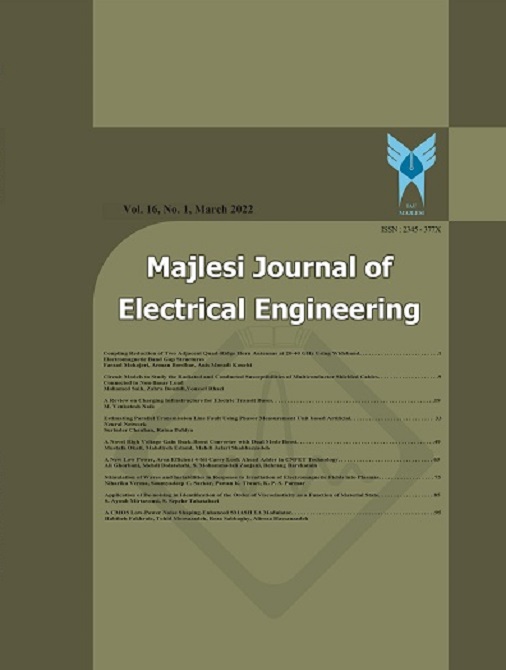[1] G. Rogers, Power system oscillations, New York: Springer-Verlag Inc, 2000.
[2] L. L. Grigsby, Power system stability and control, Bosa Roca: CRC Press Inc, 2012.
[3] S. You, G. Kou, Y. Liu, X. Zhang, Y. Cui, M. J. Till, W. Yao, and Y. Liu, “Impact of high PV penetration on the inter-area oscillations in the U.S. Eastern Interconnection,” IEEE Access, vol. 5, pp. 4361-4369, 2017. https://doi.org/10.1109/ACCESS.2017.2682260.
[4] Y. Cui, L. Wu, W. Yu, Y. Liu, W. Yao, D. Zhou, and Y. Liu, “Inter-area oscillation statistical analysis of the U.S. Eastern Interconnection,” The J. Engineering, vol. 11, pp. 595 – 605, 2017. https://doi.org/10.1049/joe.2017.0243.
[5] D. P. Wadduwage, U. D. Annakkage, and K. Narendra, “Identification of dominant low-frequency modes in ring-down oscillations using multiple Prony models,” IET Gener. Trans. & Distribu., vol. 15, pp. 2206 – 2214, 2015. https://doi.org/10.1049/iet-gtd.2014.0947.
[6] F. K. A. Lami, A new improved method to damp inter-area oscillations in power systems with SSR mitigation and zone protection compensation, Ph.D. Thesis, University of Leicester, Leicester, United Kingdom. 2012.
[7] M. Hadjikypris, Supervisory control scheme for FACTS and HVDC based damping of inter-area power oscillations in hybrid ac-dc power systems, Ph.D. Thesis, University of Manchester, Manchester, United Kingdom, 2015.
[8] P. Kundur, Power system stability and control, New York: McGraw-Hill Inc, 1994.
[9] E D. F. Peelo, D. W. Hein, and F. Peretti, “Application of a 138 kV 200 MW braking resistor,” Power Engineering Journal, vol. 84, pp. 188-192, 1994. http://dx.doi.org/10.1049/pe:19940408.
[10] M. L. Shelton, W. A. Mittelstadt, P. F. Winkelman, and W. J. Bellerby, “Bonneville power administration 1400 MW braking resistor,” IEEE Trans. Power Apparat. Syst., vol. 94, pp. 602-611, 1975. https://doi.org/10.1109/T-PAS.1975.31888.
[11] R. Preece, Improving the stability of meshed power networks: a probabilistic approach using embedded HVDC lines. Cham: Springer International Publishing AG, 2013.
[12] M. F. Ahmed, M. A. Mandor, M. El-Hadidy, and F. M. Bendary, “Fuzzy based battery energy storage system and braking resistor for mitigation of shaft-torsional oscillations,” J. King Saud Univ. – Eng. Sci, in press, 2020, https://doi.org/10.1016/j.jksues.2020.07.011.
[13] R. M. Hamouda, “Damping torsional oscillations using thyristor controlled braking resistors,” J. King Saud Univ. – Eng. Sci. vol. 13, pp. 103-116, 2001. https://doi.org/10.1016/S1018-3639(18)30728-1.
[14] A. H. M. A. Rahim, “A minimum-time based fuzzy logic dynamic braking resistor control for sub-synchronous resonance,” Electrical Power and Energy Systems, vol. 26, pp. 191–198, 2004. https://doi.org/10.1016/j.ijepes.2003.10.011.
[15] M. H. Ali, T. Murata, and J. Tamura, “The effect of temperature rise of the fuzzy controlled braking resistors on transient stability,” IEEE Trans. Power Syst., vol. 19, pp. 1085-1095. 2004. https://doi.org/10.1109/TPWRS.2004.825828.
[16] M. H. Ali, T. Murata, and J. Tamura, “Effect of coordination of optimal reclosing and fuzzy controlled braking resistor on transient stability during unsuccessful reclosing,” IEEE Trans. Power Syst., vol. 21, pp. 1321- 1330, 2006, https://doi.org/10.1109/TPWRS.2006.876670.
[17] M. H. Ali, T. Murata, and J. Tamura, “Influence of communication delay on the performance of fuzzy logic-controlled braking resistor against transient stability,” IEEE Trans. Control Syst. Technol., vol. 16, pp. 1232-1241, 2008. https://doi.org/10.1109/TCST.2008.919443.
[18] T. Hiyama, M. Mishiro, and H. Kihara, “Fuzzy logic switching of thyristor controlled braking resistor considering coordination with SVC,” IEEE Trans. Power Deliv., vol. 10, pp. 2020-2026, 1995. https://doi.org/10.110961.473348.
[19] M. Glavic, “Design of a resistive brake controller for power system stability enhancement using reinforcement learning,” IEEE Trans. Control Syst. Technol., vol. 13, pp. 743- 751, 2005. https://doi.org/10.1109/TCST. 2005.847339.
[20] F. Ishiguro, S. Tanaka, M. Shimomura, T. Maeda, K. Matsushita, and H. Sugimoto, “Coordinated stabilizing control of exciter, turbine and braking resistor,” IEEE Trans. Power Syst. vol. 1, pp. 74-80, 1986. https://doi.org/10.1109/TPWRS. 1986.4334957.
[21] S. M. Muyeen, “A combined approach of using an SDBR and a STATCOM to enhance the stability of a wind farm,” IEEE Syst. Journal, vol. 9, pp. 922-932, 2014. https://doi.org/10.1109/JSYST. 2013.2297180.
[22] J. Mendel, H. Hagras, W. W. Tan, W. W. Melek, and H. Ying, Introduction to type-2 fuzzy logic control: theory and applications, New York: John Wiley & Sons Inc, 2013.
[23] H. Altaş, Fuzzy logic control in energy systems with design applications, Stevenage: Institution of Engineering & Technology, 2017.
[24] O. Castillo, and P. Melin, Type-2 fuzzy logic: theory and applications, Berlin: Springer-Verlag, 2008.
[25] M. Klein, G. J. Rogers, and P. Kundur, “A fundamental study of inter-area oscillations in power systems,” IEEE Trans. Power Syst., vol. 6 3, pp. 914–921, https://doi.org/10.1109/59.119229
[26] E. Huseinbasic, I. Kuzle, and T. Tomisa, “Inter-area oscillations damping using dynamic braking and phasor measurements,” IEEE/PES Power Systems Conference and Exposition, pp. 1 – 6, 2009, https://doi.org/10.1109/PSCE.2009.4840068.
[27] S. Islam, P. X. Liu, and A. El Saddik, “Wide-area measurement-based power system for smart transmission grid with communication delay,” IEEE International Instrumentation and Measurement Technology Conference (I2MTC), pp. 138-143, 2012. https://doi.org/10.1109/I2MTC.2012.6229458.
[28] T. Surinkaew, and I. Ngamroo, “Inter area oscillation damping control design considering impact of variable latencies,” IEEE Trans. Power Syst., vol. 34, pp. 481-493, 2019. https://doi.org/10.1109/TPWRS.2018.2866032.
[29] J. Bladh, P. Sundqvist, and U. Lundin, “Torsional stability of hydropower units under influence of subsynchronous oscillations,” IEEE Trans. Power Syst., vol. 284, pp. 3826-3833, 2013, https://doi.org/10.1109/TPWRS.2013.2263811.
[30] P. S. Sikder, and N. Pal, “Modeling of an intelligent battery controller for standalone solar-wind hybrid distributed generation system,” J. King Saud Univ. – Eng. Sci, in press, 2019. https://doi.org/10.1016/j.jksues.2019.02.002.

